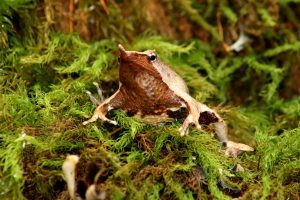An investigation focused on amphibians and reptiles in wildlife provides evidence that there is at least one species of these groups that does not experience the senescence stage, that is, they do not present an increased risk of dying as they age, despite being very long-lived species, where individuals can live for more than 100 years.
This is the main conclusion reached by a collaborative study led by Dr. Beth Reinke, from Northeastern Illinois University, together with 114 authors, using monitoring data on wildlife populations of 77 species from different parts of the world.
The work was recently published in the journal Science, an article in which the researcher Dr. Andrés Valenzuela Sánchez, assistant professor at the Faculty of Forest Sciences and Natural Resources of the Universidad Austral de Chile and president of the NGO Ranita de Darwin, participates as co-author. .
See publication in this link.
“It is known that the risk of dying increases as we age, this is a natural process called senescence. Although longevity in humans has increased considerably in recent decades and the onset of senescence has been delayed to later ages, mainly because people reach old age in better health, senescence is still an inevitable part of our lives. life”. This is how Dr. Valenzuela explained the term senescence.
But this reality does not apply to all animals, according to what was shown by the study, which included species of frogs and toads, salamanders, lizards and snakes, crocodiles, turtles and the tuatara.
Scientists studied for years, and even decades, 107 populations of 77 species of amphibians and reptiles from various parts of the globe. Only with this information were the researchers able to unravel the mysteries about aging that this group of animals hid.
“For a long time many scientists thought that wildlife animals, unlike humans, died before reaching the senescence stage, and that it was therefore not worth investigating aging in these species. Today we know not only that senescence commonly occurs in wildlife animals, but also that multiple species have managed to escape throughout their evolutionary history from this biological process that seemed inexorable to us”, commented Dr. Andrés Valenzuela.
According to the publication, among the causes that would lead some amphibians and reptiles to present slow senescence, or not present senescence at all, are the presence of shells in turtles or poison and other toxins in various species of reptiles and amphibians .
“These protective mechanisms can reduce the mortality rate. Therefore, those species are more likely to live longer and that may lead to slower evolution of senescence or no senescence at all,” said Beth Reinke.
This study also showed that in amphibians and reptiles there is a great diversity of senescence patterns, much greater than that observed in birds and mammals, with species that age very quickly and live for a few years, such as the Moller’s tree frog, which lives around four years, and others that age very slowly or do not age at all and live for many years, such as the tuatara, which can reach more than 130 years in natural conditions.
For scientists, verifying this great diversity with empirical data implies a paradigm shift in how we understand the evolution of aging in animals, which may also serve to improve our understanding of the aging process in humans.
The study highlights the importance of long-term monitoring of wildlife populations, which unfortunately has been very infrequent in some parts of the world. “Of the 77 species considered in this study, only three amphibian species from South America, Africa or Asia were included, while most of the data was obtained on species from North America, Europe and Oceania. In South America, Darwin’s frog was the only amphibian included in the study,” said Andrés Valenzuela.
The UACh researcher and the team from the NGO Ranita de Darwin have spent nine years monitoring various populations of the Darwin’s frog in the native forest of southern Chile, a famous and unique species in the world because the male takes care of the tadpoles in his vocal sac. “Long-term monitoring of Darwin’s frog populations has allowed us not only to understand the senescence process in this species, but it is also providing crucial information to design, implement and evaluate conservation actions to protect this endangered species. ”, he indicated.
He added that this study made it possible to determine for the first time and with precision the longevity of Darwin’s froglets in nature, which is close to eight years, although some exceptionally long-lived individuals can live more than 10 years.



![[Img #74675]](https://thelatestnews.world/wp-content/uploads/2024/12/They-discover-a-new-class-of-X-ray-sources-in-the-150x150.jpg)









![[Img #74675]](https://thelatestnews.world/wp-content/uploads/2024/12/They-discover-a-new-class-of-X-ray-sources-in-the-300x200.jpg)


Add Comment